What'sNEW July - Sep 2021
...although there may be life in the clouds of Venus, the detection of a simple, single gas, phosphine, is likely not a decisive indicator.
 Phosphine Generation Pathways on Rocky Planets by Arthur Omran, Christopher Oze, Brian Jackson, Chris Mehta, Laura M. Barge, Jeffrey Bada, and Matthew A. Pasek, Astrobiology, 22 Sep 2021. Phosphine Generation Pathways on Rocky Planets by Arthur Omran, Christopher Oze, Brian Jackson, Chris Mehta, Laura M. Barge, Jeffrey Bada, and Matthew A. Pasek, Astrobiology, 22 Sep 2021.
 Life on Europa, Other Moons, Other Planets? has related links. Search for "Venus". Life on Europa, Other Moons, Other Planets? has related links. Search for "Venus".
So what happened to all the cold gas in these galaxies so early on? This question comes from U. Mass. astronomer Kate Whitaker, following a look into deep space with NASA's Hubble Space Telescope and the Atacama Large Millimeter/submillimeter Array (ALMA). At this point in our universe, all galaxies should be forming lots of stars. But these galaxies apparently are spent already. Several new ideas are proposed to explain the anomaly.
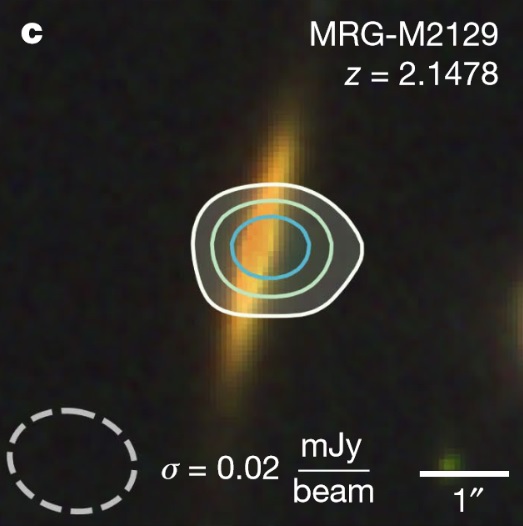
 Hubble Finds Early, Massive Galaxies Running on Empty, NASA Goddard, 22 Sep 2021. Hubble Finds Early, Massive Galaxies Running on Empty, NASA Goddard, 22 Sep 2021.
 Quenching of star formation from a lack of inflowing gas to galaxies by Katherine E. Whitaker et al., doi:10.1038/s41586-021-03806-7, Nature, 22 Sep 2021. Quenching of star formation from a lack of inflowing gas to galaxies by Katherine E. Whitaker et al., doi:10.1038/s41586-021-03806-7, Nature, 22 Sep 2021.
 Hubble telescope discovers 6 mysteriously dead, massive galaxies from early universe, by Alexandra Larkin, CBS News, 22 Sep 2021. Hubble telescope discovers 6 mysteriously dead, massive galaxies from early universe, by Alexandra Larkin, CBS News, 22 Sep 2021.
 Thanks, Rob Cooper. Thanks, Rob Cooper.
Why they shut down star formation so early is still a puzzle. Could the anomalous galaxies actually be older than consensus cosmology requires? This is only one of the puzzles confronting the standard inflationary big-bang theory.
 The End and the Big Bang has links to more puzzles and some skeptics. The End and the Big Bang has links to more puzzles and some skeptics.
Our results indicate that the protoplanetary disks studied here are host to significant reservoirs of large
organic molecules....
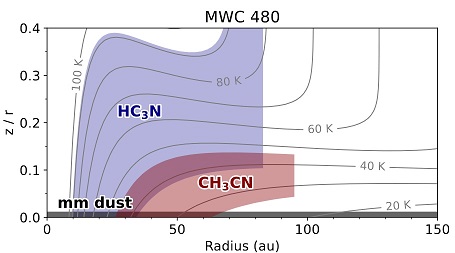
 Molecules with ALMA at Planet-forming Scales (MAPS) IX: Distribution and properties of the large organic molecules HC3N, CH3CN, and c-C3H2 by John D. Ilee et al., submitted to ApJ, draft version 16 Sep 2021; and commenary with links to related papers: Molecules with ALMA at Planet-forming Scales (MAPS) IX: Distribution and properties of the large organic molecules HC3N, CH3CN, and c-C3H2 by John D. Ilee et al., submitted to ApJ, draft version 16 Sep 2021; and commenary with links to related papers:
 ALMA Reveals Carbon-Rich, Organic Birth Environments of Planets, National Radio Astronomy Observatory +Newswise, 15 Sep 2021. ALMA Reveals Carbon-Rich, Organic Birth Environments of Planets, National Radio Astronomy Observatory +Newswise, 15 Sep 2021.
 Hoyle and Wickramasinghe's Analysis of Interstellar Dust has history and related links. Hoyle and Wickramasinghe's Analysis of Interstellar Dust has history and related links.
 Thanks, Stan Franklin. Thanks, Stan Franklin.
 Biology must generate ideas as well as data by Paul Nurse, Nature, 13 Sep 2021. Biology must generate ideas as well as data by Paul Nurse, Nature, 13 Sep 2021.
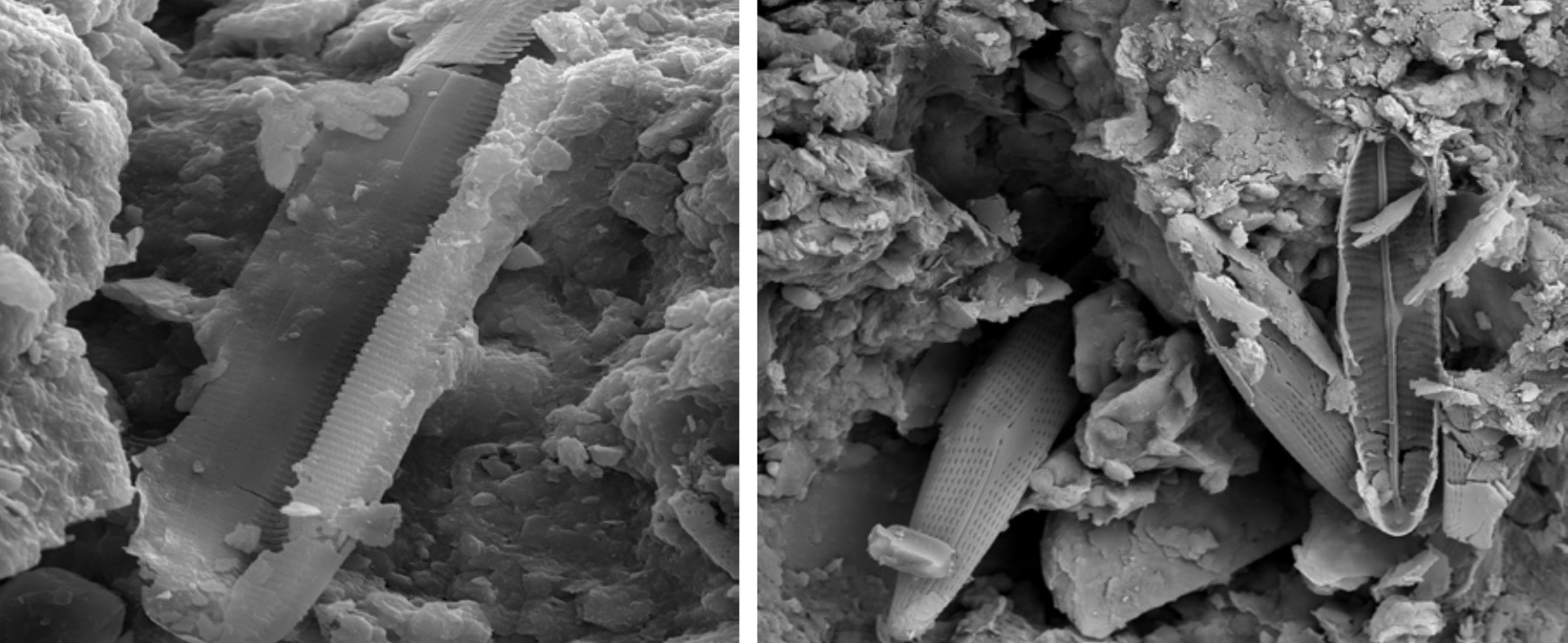
 Polonnaruwa Stones Revisited – Evidence for Non-Terrestrial Life by Milton Wainwright and Chandra Wickramasinghe, May 2021. Polonnaruwa Stones Revisited – Evidence for Non-Terrestrial Life by Milton Wainwright and Chandra Wickramasinghe, May 2021.
 11 January 2013: A carbonaceous meteorite that fell in Sri Lanka.... 11 January 2013: A carbonaceous meteorite that fell in Sri Lanka....
 Complex molecules are a sign of life, NASA says in a 5-min. video, YouTube, 02 Sep 2021. Complex molecules are a sign of life, NASA says in a 5-min. video, YouTube, 02 Sep 2021.
 17 Sep 2021: ...protoplanetary disks host large organic molecules.... 17 Sep 2021: ...protoplanetary disks host large organic molecules....
 01 Jul 2021: Complex organic structures in meteorites older than the sun. 01 Jul 2021: Complex organic structures in meteorites older than the sun.
 27 Apr 2000: Most interstellar particles captured by Stardust are complex organic compounds.... 27 Apr 2000: Most interstellar particles captured by Stardust are complex organic compounds....
 Hoyle and Wickramasinghe's Analysis of Interstellar Dust. Hoyle and Wickramasinghe's Analysis of Interstellar Dust.
A physicist at Arizona State University has lately come to appreciate the role of viruses in evolution. Publicity timed with the release of his new book allows one to think that Davies discovered germs in space, although Davies acknowledges his awareness of Fred Hoyle's work.
 Viruses may exist 'elsewhere in the universe', warns scientist, by Nicola Davis, The Guardian, 06 Sep 2021. Viruses may exist 'elsewhere in the universe', warns scientist, by Nicola Davis, The Guardian, 06 Sep 2021.
 ...scientist claims space germs could be absorbed into human DNA, by Helena Sutan, Brinkwire, 08 Sep 2021. ...scientist claims space germs could be absorbed into human DNA, by Helena Sutan, Brinkwire, 08 Sep 2021.
 What's Eating the Universe? Richard Lea reviews Paul Davies' book in The Wall Street Journal, 10 Sep 2021. What's Eating the Universe? Richard Lea reviews Paul Davies' book in The Wall Street Journal, 10 Sep 2021.
 Hoyle and Wickramasinghe's Analysis of Interstellar Dust has background dating from the 1960s. Hoyle and Wickramasinghe's Analysis of Interstellar Dust has background dating from the 1960s.
| 07 Sep 2021 |
What'sNEW about HGT  | |
|
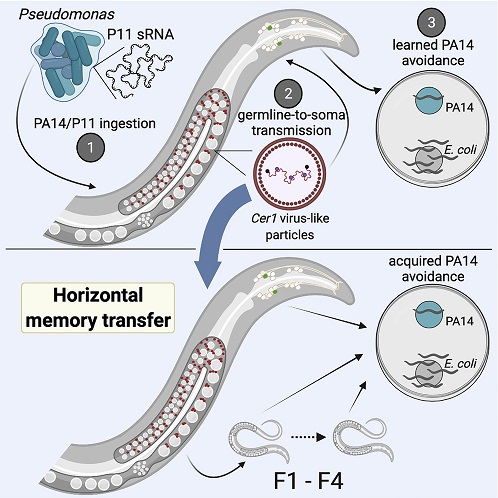 A retrotransposon transfers a learned behavior between worms. Progeny inherit it. Researchers in Coleen Murphy's lab found that mother worms who encounter pathogenic P. aeruginosa in their environment learn to avoid the bacterium via a mechanism involving the retrotransposon Cer1. Cer1 is also needed for inheritance of avoidance behavior by the worms' offspring, and its release into the environment can transfer avoidance behavior to naïve worms. (Image from Murphy Lab.)
A retrotransposon transfers a learned behavior between worms. Progeny inherit it. Researchers in Coleen Murphy's lab found that mother worms who encounter pathogenic P. aeruginosa in their environment learn to avoid the bacterium via a mechanism involving the retrotransposon Cer1. Cer1 is also needed for inheritance of avoidance behavior by the worms' offspring, and its release into the environment can transfer avoidance behavior to naïve worms. (Image from Murphy Lab.)
 "The role of the Cer1 transposon in horizontal transfer of transgenerational memory" by Rebecca S. Moore, Rachel Kaletsky, Chen Lesnik et al.,
doi:10.1016/j.cell.2021.07.022, Cell, 02 Sep 2021. "The role of the Cer1 transposon in horizontal transfer of transgenerational memory" by Rebecca S. Moore, Rachel Kaletsky, Chen Lesnik et al.,
doi:10.1016/j.cell.2021.07.022, Cell, 02 Sep 2021.
 Murphy Lab scientists discover a mechanism for memory transfer between individuals in C. elegans, by Caitlin Sedwick, Princeton University +Newswise, 02 Sep 2021. Murphy Lab scientists discover a mechanism for memory transfer between individuals in C. elegans, by Caitlin Sedwick, Princeton University +Newswise, 02 Sep 2021.
 Viruses and Other Gene Transfer Mechanisms has more. Viruses and Other Gene Transfer Mechanisms has more.
According to cosmic ancestry, genetic programming must be originally supplied by some means of horizontal gene transfer (HGT). After transfer, robust software management systems within genomes must recognize, reject-or-not, install, maybe duplicate, relocate, activate, test, tinker and optimize — or save-for-later — the acquired sequences. Evidence for these phenomena is becoming undeniable. (Vertical inheritance and natural selection still function.)
An example of this software management capability comes from the genomes of ciliates, unicellular eukaryotes with separate germline and somatic genomes in the same cytoplasm. The somatic macronucleus (MAC), responsible for gene expression, is not sexually transmitted but develops from a copy of the germline micronucleus (MIC) at each sexual generation. This is amazing. And there's more.

In the ciliate Paramecium tetraurelia, half of the c. 40,000 genes in the MAC are originally interrupted by large regions containing c. 45,000 unique, short, interspersed sequences. Most of these disruptive strands, called internal eliminated sequences (IESs), are found in protein-coding genes. Fortunately, a system as precise as RNA splicing — but at the DNA level — removes them, every reproductive cycle. What accounts for all of this? Perhaps the IESs are leftover transposons that just happened to acquire excising end-motifs?
French biologists have carefully studied the gene-editing system that streamlines the MAC genome. They conclude, Despite significant progress in characterization of the mechanisms underlying IES elimination, the evolutionary origin of IESs remains mysterious.
May I politely ask a broader question: How could darwinian evolution invent programming for the whole ciliate MAC/MIC phenomenon?
 "Massive colonization of protein-coding exons by selfish genetic elements in Paramecium germline genomes" by Sellis D, Guérin F, Arnaiz O, Pett W, Lerat E, Boggetto N, et al., doi:10.1371/journal.pbio.3001309, PLoS Biol, 29 Jul 2021. "Massive colonization of protein-coding exons by selfish genetic elements in Paramecium germline genomes" by Sellis D, Guérin F, Arnaiz O, Pett W, Lerat E, Boggetto N, et al., doi:10.1371/journal.pbio.3001309, PLoS Biol, 29 Jul 2021.
 "Transposon debris in ciliate genomes" by Feng Y and Landweber LF, PLoS Biol, 24 Aug 2021. "Transposon debris in ciliate genomes" by Feng Y and Landweber LF, PLoS Biol, 24 Aug 2021.
 Robust Software Management... [incomplete] and Robust Software Management... [incomplete] and
 Introns...
have related discussion and updates. Introns...
have related discussion and updates.
Tanpopo is JAXA's longrunning experiment on ISS to seek evidence of panspermia. An open-access review of Tanpopo includes an excerpt that reminds us: biology is the most likely source for organics in space:
|
"Although some amino acids and nucleic acids could be formed in slightly reducing gas mixtures ...by particle irradiation or in high-temperature plasma ...prebiotic formation of amino acids and other organic compounds would be more difficult than previously believed. ...A wide variety of organic compounds have been found in such extraterrestrial bodies as meteorites (carbonaceous chondrites) and comets.... Amino acids have been detected in hot water extracts from carbonaceous chondrites, and more than 80 amino acids have been identified from the Murchison meteorite (Glavin et al.,2020). Amino acids found in carbonaceous chondrites were mostly racemic mixtures, but Cronin and Pizzarello (1997) found enantiomeric excesses of some amino acids in the Murchison meteorite...."
|
In fact, remnant enantiomeric excesses in amino acids are found in most carbonaceous meteorites, and always lefthanded — lifelike . The authors also reference Chyba and Sagan (doi:10.1038/355125a0, Nature, 09 Jan 1992) who wrote:
|
"3.2 x 10^5 kg/yr of intact organic carbon is curently delivered to Earth on interplanetary dust particles (IDPs)."
|
 "Scientific Targets of Tanpopo..." by Akihiko Yamagishi et al.,
Astrobiology, online 27 Aug 2021. "Scientific Targets of Tanpopo..." by Akihiko Yamagishi et al.,
Astrobiology, online 27 Aug 2021.
 11 March 2010 and 11 March 2010 and
 26 Aug 2020: Tanpopo updates. 26 Aug 2020: Tanpopo updates.
 Comets... Comets...
 ...Interstellar Dust and ...Interstellar Dust and
 ...Murchison Meteorite have background and updates. ...Murchison Meteorite have background and updates.
George Gamow and Fred Hoyle are clearly and sensitively portrayed in Flashes of Creation by Paul Halpern. Both of them wrote excellent popular science and science fiction, and both were brilliant, pioneering cosmologists. Their life stories, while contrasting, overlap and easily weave together.

Gamow is less familiar to me, so I was glad to know more about his role in twentieth century cosmology. This began with a wondering: how did the elements got their realtive abundances? His work, with others, led to today's consensus about hydrogen, helium and the big bang theory. Hoyle wondered the same thing, and successfully showed how the elements from lithium to iron are made in stars. His insight about carbon 12 was ingenious. Still, he always tinkered with versions of steady-state cosmology, even after the big bang became the overwhelming consensus.
I enjoyed seeing Fred Hoyle so clearly and vividly. Episodes with Geoffrey and Margaret Burbidge reminded me of the day I met him 25 years ago. During our 3-hour interview mainly about panspermia he also talked about current issues in cosmology. Light from quasars is strongly redshifted, indicating they are very distant. But a deep gravity well can also redshift light, so maybe they aren't so distant. Besides, their small angular separation from galaxies known to be close by is, statistically, hard to explain. Afterward, he, his grandaughter Nicola and I went to a pub to dine with the Burbidges. They were keen to discuss with him the latest data about quasars and related topics. But Fred was entirely distracted by the cricket match on TV!
Flashes of Creation is a fascinating look at science, who does it and how it gets done: it's even more political, cliqueish, quirky, labarinthine, incremental and error-prone than we usually hear. And colossal "mistakes" may turn out approximately right after all, like Einstein's cosmological constant. And maybe panspermia, we remind Halpern. But he's a physicist. And, he writes popular science, so he is especially comfortable with Gamow and Hoyle. The story is edifying, delightful and very well told. This book is excellent!
 Flashes of Creation: George Gamow, Fred Hoyle, and the Great Big Bang Debate, Basic Books, 17 Aug 2021. Flashes of Creation: George Gamow, Fred Hoyle, and the Great Big Bang Debate, Basic Books, 17 Aug 2021.
 "Before the Big Bang became scientific dogma" (book review) by Simon Mitton, Science, 20 Aug 2021. "Before the Big Bang became scientific dogma" (book review) by Simon Mitton, Science, 20 Aug 2021.
 Fred Hoyle... has our 1996 interview and links. Fred Hoyle... has our 1996 interview and links.
 The End and the Big Bang has discussion and updates. The End and the Big Bang has discussion and updates.
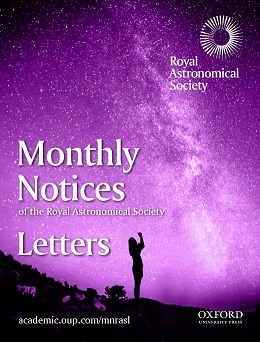
 Interstellar objects outnumber Solar system objects in the Oort cloud [abstract], by Amir Siraj and Avi Loeb, doi:10.1093/mnrasl/slab084, Mon. Not. RAS: Letters, Oct 2021.
~1 per cent of carbon and oxygen in the Milky Way Galaxy may be locked in interstellar objects.... Interstellar objects outnumber Solar system objects in the Oort cloud [abstract], by Amir Siraj and Avi Loeb, doi:10.1093/mnrasl/slab084, Mon. Not. RAS: Letters, Oct 2021.
~1 per cent of carbon and oxygen in the Milky Way Galaxy may be locked in interstellar objects....
 ...the Oort Cloud may be home to more visiting objects than objects that belong to our solar system., Harvard and Smithsonian Center for Astrophysics, 22 Aug 2021. ...the Oort Cloud may be home to more visiting objects than objects that belong to our solar system., Harvard and Smithsonian Center for Astrophysics, 22 Aug 2021.
 A Huge Population of Interstellar Comets in the Oort Cloud by Paul Gilster, Centauri Dreams, 25 Aug 2021. A Huge Population of Interstellar Comets in the Oort Cloud by Paul Gilster, Centauri Dreams, 25 Aug 2021.
 Comets: they can traverse the galaxy, and their contents are consistent with life. Comets: they can traverse the galaxy, and their contents are consistent with life.
We define life as the union of two crucial energetic and informatic processes producing an autonomous system that can metabolically extract and encode information from the environment ...and propagate it forward....
 "The Multiple Paths to Multiple Life" by Christopher P. Kempes and David C. Krakauer, Journal of Molecular Evolution, 12 Jul 2021; and commentary: "The Multiple Paths to Multiple Life" by Christopher P. Kempes and David C. Krakauer, Journal of Molecular Evolution, 12 Jul 2021; and commentary:
 "...new theory of life's multiple origins", Santa Fe Institute, 16 Aug 2021. "...new theory of life's multiple origins", Santa Fe Institute, 16 Aug 2021.
 What Is Life? has our definition and more. What Is Life? has our definition and more.
 The RNA World... describes origin-of-life theories. The RNA World... describes origin-of-life theories.
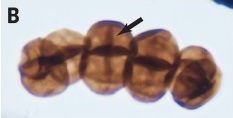 "Molecular time trees indicating that embryophytes originated around 500 million years ago (Ma) during the Cambrian are at odds with the record of fossil plants, which first appear in the mid-Silurian almost 80 million years later." Now paleobotanists have found "fossilized spores whose characteristics raise the possibility that land plants arose by co-opting algal genes, along with acquiring de novo genes, and that the former would account for the molecular clock predating the fossil record."
"Molecular time trees indicating that embryophytes originated around 500 million years ago (Ma) during the Cambrian are at odds with the record of fossil plants, which first appear in the mid-Silurian almost 80 million years later." Now paleobotanists have found "fossilized spores whose characteristics raise the possibility that land plants arose by co-opting algal genes, along with acquiring de novo genes, and that the former would account for the molecular clock predating the fossil record."
 "A fossil record of land plant origins from charophyte algae" by Paul K. Strother and Clinton Foster, doi:10.1126/science.abj2927, Science, 13 Aug 2021. "A fossil record of land plant origins from charophyte algae" by Paul K. Strother and Clinton Foster, doi:10.1126/science.abj2927, Science, 13 Aug 2021.
 "When did terrestrial plants arise?" by Patricia G. Gensel, Science, 13 Aug 2021.
When molecular clocks and fossils disagree, the genes always look too old. "When did terrestrial plants arise?" by Patricia G. Gensel, Science, 13 Aug 2021.
When molecular clocks and fossils disagree, the genes always look too old.
 Metazoan Genes Older Than Metazoa? and Metazoan Genes Older Than Metazoa? and
 Genes Older Than Earth? have more. Genes Older Than Earth? have more.
 ...De Novo Genes has early notice and updated examples of them. ...De Novo Genes has early notice and updated examples of them.
Worth a look, at least. The "blueberries," for example, deserve scrutiny.
 Proof of Life on Mars in 200 Pictures: "Algae, Microbial Mats, Stromatolites, Lichens, Fungus, Fossils, Growth, Movement, Spores and Reproductive Behavior", Rhawn Joseph et al., ResearchGate, Aug 2021. Proof of Life on Mars in 200 Pictures: "Algae, Microbial Mats, Stromatolites, Lichens, Fungus, Fossils, Growth, Movement, Spores and Reproductive Behavior", Rhawn Joseph et al., ResearchGate, Aug 2021.
 Thanks, Stan Franklin. Thanks, Stan Franklin.
 Life on Mars! has background. Life on Mars! has background.
Worth a listen, not because I am sure that this virus recently came from space, but because it's possible:
 Origin and Spread COVID-19: Immunologist Ted Steele, 40-minute YouTube video, 02 Aug 2021. Origin and Spread COVID-19: Immunologist Ted Steele, 40-minute YouTube video, 02 Aug 2021.
 27 Feb 2020: How has Coronavirus spread? 27 Feb 2020: How has Coronavirus spread?
| 31 Jul 2021 |
What'sNEW about HGT  | |
|
Our results suggest that the driving force in the virus-parasitoid-lepidopteran host arms race is derived ...also by gene transfers that provide target-specific weapons....
 "Horizontally transmitted parasitoid killing factor shapes insect defense to parasitoids" by Martin A. Erlandson, Salvador Herrero, Madoka Nakai et al., doi:10.1126/science.abb6396, Science, 30 Jul 2021. "Horizontally transmitted parasitoid killing factor shapes insect defense to parasitoids" by Martin A. Erlandson, Salvador Herrero, Madoka Nakai et al., doi:10.1126/science.abb6396, Science, 30 Jul 2021.
 "Genes Shared With Viruses Protect Caterpillars..." by Stephanie Melchor, The Scientist, 30 Jul 2021. "Genes Shared With Viruses Protect Caterpillars..." by Stephanie Melchor, The Scientist, 30 Jul 2021.
 Caterpillars borrow weapons from viruses..., University of Saskatchewan +Phys.org, 29 Jul 2021. Caterpillars borrow weapons from viruses..., University of Saskatchewan +Phys.org, 29 Jul 2021.
 "The Presence of Ancient Core Genes Reveals Endogenization from Diverse Viral Ancestors in Parasitoid Wasps" by Gaelen R Burke et al., doi:10.1093/gbe/evab105, Genome Biology and Evolution, Jul 2021. "The Presence of Ancient Core Genes Reveals Endogenization from Diverse Viral Ancestors in Parasitoid Wasps" by Gaelen R Burke et al., doi:10.1093/gbe/evab105, Genome Biology and Evolution, Jul 2021.
 Viruses and Other Gene Transfer Mechanisms has more. Viruses and Other Gene Transfer Mechanisms has more.
 Gilbert Victor Levin died, Monday, 26 July, at the age of 97. He had been in good health until that morning, when he suffered a dissection in his aorta. A team member on the ESA's 2022 ExoMars Habit experiment, he was actively studying extant microbial life on Mars.
Gilbert Victor Levin died, Monday, 26 July, at the age of 97. He had been in good health until that morning, when he suffered a dissection in his aorta. A team member on the ESA's 2022 ExoMars Habit experiment, he was actively studying extant microbial life on Mars.
In 1976, his "Labelled Release" life-detection experiment flown on NASA's Viking mission got positive results. He endorsed that finding with eloquence, logic and good data, until he died. I was fortunate to know him.

 "Gilbert V. Levin, Who Said He Found Signs of Life on Mars, Dies at 97", by Kenneth Chang, The New York Times, 05 Aug 2021. "Gilbert V. Levin, Who Said He Found Signs of Life on Mars, Dies at 97", by Kenneth Chang, The New York Times, 05 Aug 2021.
 "Gilbert Levin... dies at 97", by Matt Schudel, Washington Post, 03 Aug 2021. "Gilbert Levin... dies at 97", by Matt Schudel, Washington Post, 03 Aug 2021.
 Dr. Gilbert V. Levin. Dr. Gilbert V. Levin.
 Thanks, for an alert, Richard Hoover. Thanks, for an alert, Richard Hoover.
30 Jul 2021:  45 years ago today, Levin's team at NASA concluded that Mars has life. 45 years ago today, Levin's team at NASA concluded that Mars has life.
 Search for Life on Mars and the Legacy of Gilbert Levin by N. Chandra Wickramasinghe, Journal of Astrobiology & Outreach, 31 Aug 2021. Search for Life on Mars and the Legacy of Gilbert Levin by N. Chandra Wickramasinghe, Journal of Astrobiology & Outreach, 31 Aug 2021.
 Life on Mars! has background and
updates about Viking. Life on Mars! has background and
updates about Viking.
...on Earth phosphine is exclusively associated with anthropogenic and biological sources.
 "Phosphine on Venus Cannot Be Explained by Conventional Processes" by William Bains et al., doi:10.1089/ast.2020.2352, Astrobiology, online 19 Jul 2021. "Phosphine on Venus Cannot Be Explained by Conventional Processes" by William Bains et al., doi:10.1089/ast.2020.2352, Astrobiology, online 19 Jul 2021.
 14 Sep 2020: Our first notice with updates. 14 Sep 2020: Our first notice with updates.
| 22 Jul 2021 |
What'sNEW about HGT  | |
|
 15,000-Year-Old Viruses Discovered in Tibetan Glacier Ice by Laura Arenschield, Ohio State News +Newswise, 20 Jul 2021.
Most of the viruses were previously unknown.... 15,000-Year-Old Viruses Discovered in Tibetan Glacier Ice by Laura Arenschield, Ohio State News +Newswise, 20 Jul 2021.
Most of the viruses were previously unknown....
 "Glacier ice archives nearly 15,000-year-old microbes and phages" by Zhong, ZP., Tian, F., Roux, S. et al., Microbiome, 20 Jul 2021. "Glacier ice archives nearly 15,000-year-old microbes and phages" by Zhong, ZP., Tian, F., Roux, S. et al., Microbiome, 20 Jul 2021.
 Viruses... has more. Viruses... has more.
| 19 Jul 2021 |
What'sNEW about HGT  | |
|
We infer that these are a new type of archaeal extrachromosomal element [ECE] with a distinct evolutionary origin.
The new ECEs are far larger than usual — 600,000 to a million nucleotide pairs in a linear DNA stucture. They contain mostly unfamiliar genes, lotsa genes with a variety of functions, and even genes that resemble highly conserved eukaryotic ones. Nineteen different types (designated with colors) have been observed in archaea in California and Colorado. "Borgs" is their suggested nickname, because they appear to have scavenged genes from diverse sources. Geomicrobiologist and team leader Jill Banfield describes them as "a toolbox" of genes that can provide useful capabilities to a species. We know that HGT drives prokaryotic evolution, and large ECEs, "megaplasmids," have been transferred within soil bacteria. Now we see that a Borg is likely another, capacious, gene transfer agent.
 "Borgs are giant extrachromosomal elements with the potential to augment methane oxidation" by Basem Al-Shayeb et al., bioRxiv, doi:10.1101/2021.07.10.451761, posted 10 Jul 2021; and commentary: "Borgs are giant extrachromosomal elements with the potential to augment methane oxidation" by Basem Al-Shayeb et al., bioRxiv, doi:10.1101/2021.07.10.451761, posted 10 Jul 2021; and commentary:
 "...'Borgs,' recovered from California mud" by Elizabeth Pennisi, Science, 15 Jul 2021. "...'Borgs,' recovered from California mud" by Elizabeth Pennisi, Science, 15 Jul 2021.
 "Massive DNA 'Borg' structures perplex scientists" by Amber Dance, Nature, 16 Jul 2021. "Massive DNA 'Borg' structures perplex scientists" by Amber Dance, Nature, 16 Jul 2021.
 Thanks, Martin Langford. Thanks, Martin Langford.
 Viruses and Other Gene Transfer Mechanisms has more. Viruses and Other Gene Transfer Mechanisms has more.
 Kevin Dougherty et al., "Multiple Phenotypic Changes Associated with Large-scale Horizontal Gene Transfer" doi:10.1371/journal.pone.0102170, PLoS One, 21 Jul 2014. "(~1Mb megaplasmid) within Pseudomonas stutzeri...." Kevin Dougherty et al., "Multiple Phenotypic Changes Associated with Large-scale Horizontal Gene Transfer" doi:10.1371/journal.pone.0102170, PLoS One, 21 Jul 2014. "(~1Mb megaplasmid) within Pseudomonas stutzeri...."
An international team endorses a new computer model to explain diversification. Big paper, open acces:
 "gen3sis: A general engine for eco-evolutionary simulations of the processes that shape Earth's biodiversity" by Oskar Hagen et al., doi:10.1371/journal.pbio.3001340, PLoS Biol, 12 Jul 2021.
Innovation is more than diversification. Hagen et al. may know this, but many darwinists seem not to. "gen3sis: A general engine for eco-evolutionary simulations of the processes that shape Earth's biodiversity" by Oskar Hagen et al., doi:10.1371/journal.pbio.3001340, PLoS Biol, 12 Jul 2021.
Innovation is more than diversification. Hagen et al. may know this, but many darwinists seem not to.
 The Evolution Prize:
For a Demonstration of Open-Ended Evolutionary Innovation in a Closed System, 2006. The Evolution Prize:
For a Demonstration of Open-Ended Evolutionary Innovation in a Closed System, 2006.
...I believe we need alternative theories about what the universe was doing before it was expanding.
 "James Peebles: a life in cosmology", interview by Sergio de Regules, Physics World, 02 Jul 2021. "James Peebles: a life in cosmology", interview by Sergio de Regules, Physics World, 02 Jul 2021.
 15 Nov 2019: ...no good theory of such a thing as the beginning — James Peebles, 2019. 15 Nov 2019: ...no good theory of such a thing as the beginning — James Peebles, 2019.
 08 Nov 2022: The Whole Truth... by P.J.E Peebles, Princeton University Press, Aug 2022. 08 Nov 2022: The Whole Truth... by P.J.E Peebles, Princeton University Press, Aug 2022.
 The End... has more about alternatives. The End... has more about alternatives.
 The Beginning has philosophical discussion. The Beginning has philosophical discussion.
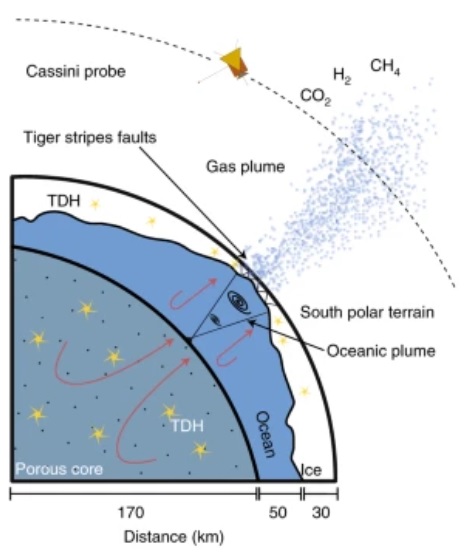 Methane in the plumes on Enceladus could well come from life. Known geochemical processes like serpentinization (formula below) wouldn't produce enough to explain it, according to a new statistical analysis.
Methane in the plumes on Enceladus could well come from life. Known geochemical processes like serpentinization (formula below) wouldn't produce enough to explain it, according to a new statistical analysis.
 "Bayesian analysis of Enceladus's plume data to assess methanogenesis" by Régis Ferrière, Stéphane Mazevet et al., Nature Astronomy, 07 Jul 2021; and ambivalent commentary: "Bayesian analysis of Enceladus's plume data to assess methanogenesis" by Régis Ferrière, Stéphane Mazevet et al., Nature Astronomy, 07 Jul 2021; and ambivalent commentary:
 Methane in plume of Saturn's moon Enceladus could be sign of alien life... by Mike Wall, Space.com, 09 Jul 2021. Methane in plume of Saturn's moon Enceladus could be sign of alien life... by Mike Wall, Space.com, 09 Jul 2021.
 An unknown methane-producing process is likely at work... by Daniel Stolte, University of Arizona, 06 Jul 2021. An unknown methane-producing process is likely at work... by Daniel Stolte, University of Arizona, 06 Jul 2021.
 Thanks, Ted Steele. Thanks, Ted Steele.

If you are an astrobiology instructor, a textbook published in 2007 should perhaps get onto your radar. Complete Course in Astrobiology covers a wide spectrum in twelve chapters by chosen experts. Following consensus, it rests on the assumptions that 1) everything began with the big bang, and 2) life must originate. The "logic" behind the latter took my breath away: Because life can originate only from preexisting life, it has a history and therefore an origin, which must be understood and explained by chemists.
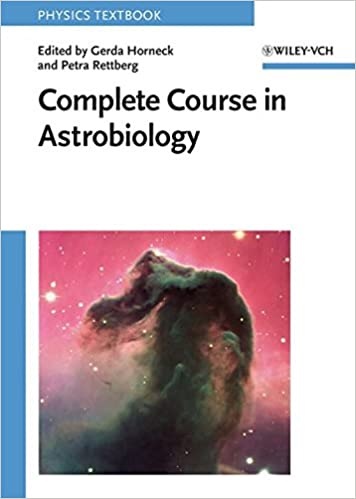
Blindness like this is common within science, where specialties are narrow and excommunication is a ready threat. Here, neo-darwinism's ability to produce the software for the origin-of-life and continuing macroevolutionary advances is never questioned. And experimental evidence that would support that capability, in vivo or in silico, is deemed unnecessary. (At least molecular biologist Kirsi Lehto is aware of HGT and viruses.) Titan's dense atmosphere is analysed only for its prebiotic potential — nevermind how it came to be ∼95% nitrogen and ∼5% methane. But the science actually discussed at length is well-referenced and hasn't changed much in the intervening years. So, here is a fine, strictly orthodox, nearly current academic resource.
 Complete Course in Astrobiology [pdf], Gerda Horneck and Petra Rettberg, eds., ISBN:978-3-527-40660-9, 414 pages, Wiley-VCH GmbH KGaA, Weinheim, Feb 2007. Complete Course in Astrobiology [pdf], Gerda Horneck and Petra Rettberg, eds., ISBN:978-3-527-40660-9, 414 pages, Wiley-VCH GmbH KGaA, Weinheim, Feb 2007.
 The RNA World... has our intro and updates for origin-of-life research. I welcome informed comments. The RNA World... has our intro and updates for origin-of-life research. I welcome informed comments.
Complex organic structures formed in meteorites older than the sun. A couple of research chemists propose that gas-phase chemistry may have have formed them. We wonder if life made the amino acids they contain.
 Polymers in Meteorites Provide Clues to Early Solar System, American Institute of Physics, +Newswise, re: Polymers in Meteorites Provide Clues to Early Solar System, American Institute of Physics, +Newswise, re:
 "Structural organization of space polymers" by Julie E M McGeoch and Malcolm W McGeoch, doi:10.1063/5.0054860, Physics of Fluids, 29 Jun 2021. "Structural organization of space polymers" by Julie E M McGeoch and Malcolm W McGeoch, doi:10.1063/5.0054860, Physics of Fluids, 29 Jun 2021.
![]()
|



 A retrotransposon transfers a learned behavior between worms. Progeny inherit it. Researchers in Coleen Murphy's lab found that mother worms who encounter pathogenic P. aeruginosa in their environment learn to avoid the bacterium via a mechanism involving the retrotransposon Cer1. Cer1 is also needed for inheritance of avoidance behavior by the worms' offspring, and its release into the environment can transfer avoidance behavior to naïve worms. (Image from Murphy Lab.)
A retrotransposon transfers a learned behavior between worms. Progeny inherit it. Researchers in Coleen Murphy's lab found that mother worms who encounter pathogenic P. aeruginosa in their environment learn to avoid the bacterium via a mechanism involving the retrotransposon Cer1. Cer1 is also needed for inheritance of avoidance behavior by the worms' offspring, and its release into the environment can transfer avoidance behavior to naïve worms. (Image from Murphy Lab.)


 "Molecular time trees indicating that embryophytes originated around 500 million years ago (Ma) during the Cambrian are at odds with the record of fossil plants, which first appear in the mid-Silurian almost 80 million years later." Now paleobotanists have found "fossilized spores whose characteristics raise the possibility that land plants arose by co-opting algal genes, along with acquiring de novo genes, and that the former would account for the molecular clock predating the fossil record."
"Molecular time trees indicating that embryophytes originated around 500 million years ago (Ma) during the Cambrian are at odds with the record of fossil plants, which first appear in the mid-Silurian almost 80 million years later." Now paleobotanists have found "fossilized spores whose characteristics raise the possibility that land plants arose by co-opting algal genes, along with acquiring de novo genes, and that the former would account for the molecular clock predating the fossil record."


 Methane in the plumes on Enceladus could well come from life. Known geochemical processes like serpentinization (formula below) wouldn't produce enough to explain it, according to a new statistical analysis.
Methane in the plumes on Enceladus could well come from life. Known geochemical processes like serpentinization (formula below) wouldn't produce enough to explain it, according to a new statistical analysis.



